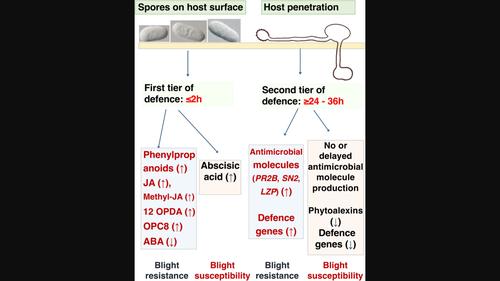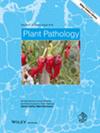Differential expression of antimicrobial metabolites, phenylpropanoid and phytohormone metabolic pathway genes determines resistance or susceptibility to Ascochyta rabiei in chickpea
IF 2.4
3区 农林科学
Q1 AGRONOMY
引用次数: 0
Abstract
Blight caused by Ascochyta rabiei is a major constraint in the productivity of chickpea (Cicer arietinum). The mechanisms governing resistance/susceptibility to blight in chickpea are poorly understood. We used a blight-resistant (HC1) and a blight-susceptible (GPF2) genotype of chickpea and genes of pathogenesis-related proteins (PRPs), phenylpropanoid pathway metabolites, abscisic acid (ABA), gibberellic acid (GA) and jasmonic acid (JA) to understand the role of these in A. rabiei resistance/susceptibility. The JA, ABA and GA biosynthesis genes of chickpea were retrieved, characterized and gene-specific primers were used for transcriptional studies. Gene expression revealed that chickpea activated its defences rather quickly and well before initiation of spore germination. In resistant HC1, the majority of the JA, GA and phenylpropanoid pathway genes had peak maxima at 2 h post-inoculation (hpi) whereas PRPs/defence genes had peak maxima at 24/36 hpi implying that defence to A. rabiei in chickpea is composed of a two-tier system separated by time: immediately after spore attachment and at or just prior to host penetration. Unlike HC1, susceptible GPF2 was late in activation of defence responses or did not activate them. Another striking difference between HC1 and GPF2 was up-regulation of ABA biosynthesis genes in inoculated GPF2 and down-regulation in HC1. This study revealed that phenylpropanoids, PRPs, JA, 8-(1R,2R)-3-oxo-2-(Z)-pent-2-enyl cyclopentyl octanoate, (15Z)-12-oxophyto-10,15-dienoic acid and methyl-jasmonate govern resistance to A. rabiei in chickpea whereas ABA governs susceptibility.

抗菌代谢物、苯丙氨酸和植物激素代谢途径基因的差异表达决定了鹰嘴豆对雷蟠菌(Ascochyta rabiei)的抗性或易感性
Ascochyta rabiei 引起的枯萎病是鹰嘴豆(Cicer arietinum)产量的主要限制因素。人们对鹰嘴豆抗/感枯萎病的机制知之甚少。我们利用鹰嘴豆的抗枯萎病基因型(HC1)和易感枯萎病基因型(GPF2)以及病原相关蛋白(PRPs)、苯丙酮途径代谢产物、脱落酸(ABA)、赤霉素(GA)和茉莉酸(JA)的基因来了解这些基因在 A. rabiei 抗性/易感性中的作用。对鹰嘴豆的 JA、ABA 和 GA 生物合成基因进行了检索和鉴定,并使用基因特异性引物进行转录研究。基因表达显示,鹰嘴豆在孢子萌发之前就迅速启动了防御机制。在抗性 HC1 中,大多数 JA、GA 和苯丙氨酸途径基因在接种后 2 小时(hpi)达到最大峰值,而 PRPs/防御基因在 24/36 小时(hpi)达到最大峰值,这意味着鹰嘴豆对 A. rabiei 的防御由两层系统组成,这两层系统在时间上是分开的:孢子附着后立即防御,在寄主穿透时或穿透前防御。与 HC1 不同,易感的 GPF2 在激活防御反应方面较晚,或者没有激活防御反应。HC1 和 GPF2 之间的另一个显著差异是,接种 GPF2 的 ABA 生物合成基因上调,而 HC1 则下调。这项研究表明,苯丙酮类、PRPs、JA、8-(1R,2R)-3-氧代-2-(Z)-戊-2-烯基环戊基辛酸酯、(15Z)-12-氧代-10,15-二烯酸和甲基-茉莉酮酸能调节鹰嘴豆对 A. rabiei 的抗性,而 ABA 能调节鹰嘴豆对 A. rabiei 的易感性。
本文章由计算机程序翻译,如有差异,请以英文原文为准。
求助全文
约1分钟内获得全文
求助全文
来源期刊

Plant Pathology
生物-农艺学
CiteScore
5.60
自引率
7.40%
发文量
147
审稿时长
3 months
期刊介绍:
This international journal, owned and edited by the British Society for Plant Pathology, covers all aspects of plant pathology and reaches subscribers in 80 countries. Top quality original research papers and critical reviews from around the world cover: diseases of temperate and tropical plants caused by fungi, bacteria, viruses, phytoplasmas and nematodes; physiological, biochemical, molecular, ecological, genetic and economic aspects of plant pathology; disease epidemiology and modelling; disease appraisal and crop loss assessment; and plant disease control and disease-related crop management.
 求助内容:
求助内容: 应助结果提醒方式:
应助结果提醒方式:


